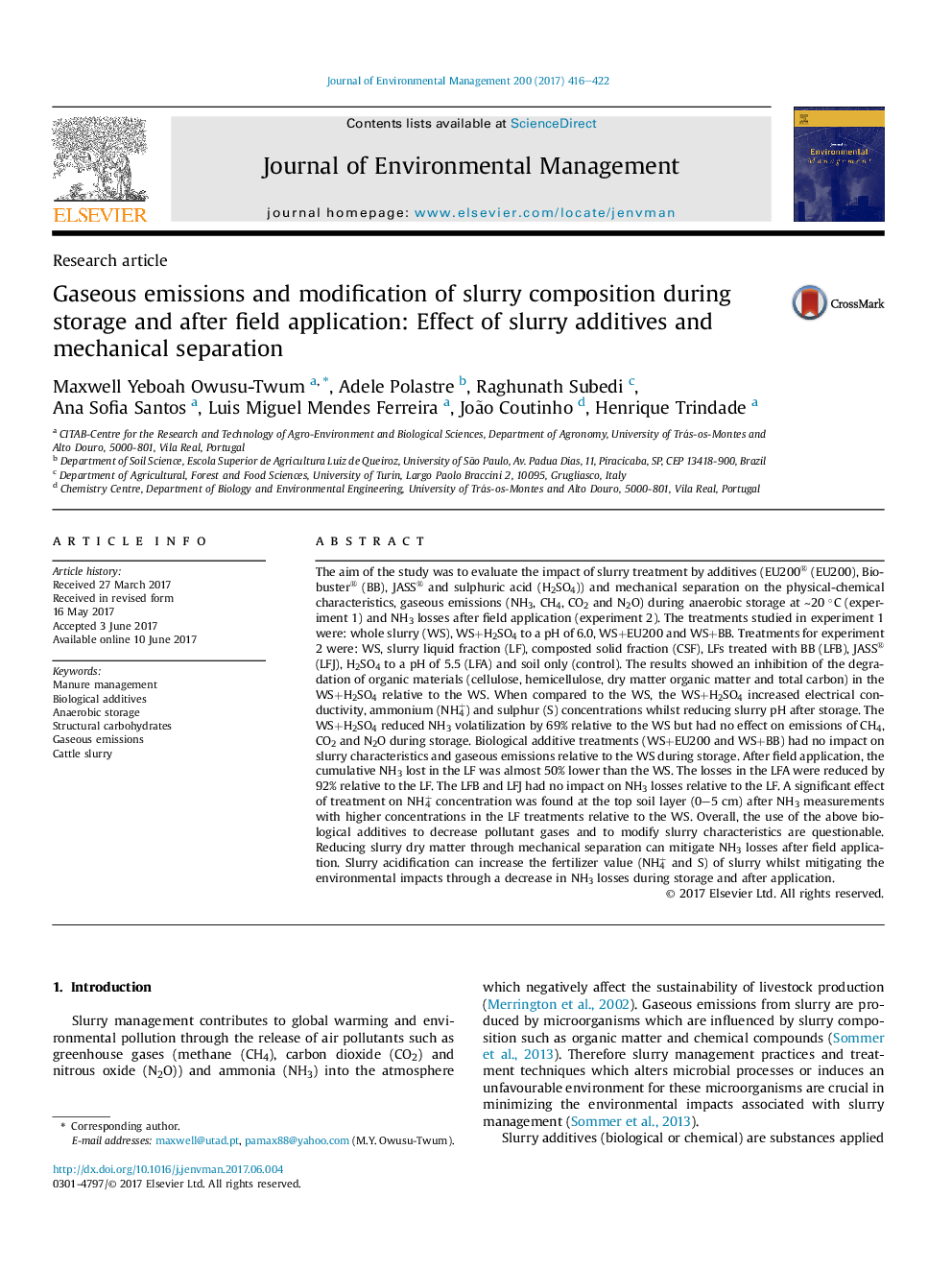| کد مقاله | کد نشریه | سال انتشار | مقاله انگلیسی | نسخه تمام متن |
|---|---|---|---|---|
| 5116351 | 1485217 | 2017 | 7 صفحه PDF | دانلود رایگان |
عنوان انگلیسی مقاله ISI
Gaseous emissions and modification of slurry composition during storage and after field application: Effect of slurry additives and mechanical separation
ترجمه فارسی عنوان
انتشار گازهای گلخانه ای و اصلاح ترکیب دوغاب در حین ذخیره و پس از استفاده از مزرعه: اثر افزودنی های لجن و جداسازی مکانیکی
دانلود مقاله + سفارش ترجمه
دانلود مقاله ISI انگلیسی
رایگان برای ایرانیان
کلمات کلیدی
مدیریت کود، افزودنیهای زیستی، ذخیره سازی بی هوازی، کربوهیدراتهای ساختاری، انتشار گازهای گلخانه ای، دوغاب گاو،
موضوعات مرتبط
مهندسی و علوم پایه
مهندسی انرژی
انرژی های تجدید پذیر، توسعه پایدار و محیط زیست
چکیده انگلیسی
The aim of the study was to evaluate the impact of slurry treatment by additives (EU200® (EU200), Bio-buster® (BB), JASS® and sulphuric acid (H2SO4)) and mechanical separation on the physical-chemical characteristics, gaseous emissions (NH3, CH4, CO2 and N2O) during anaerobic storage at â¼20 °C (experiment 1) and NH3 losses after field application (experiment 2). The treatments studied in experiment 1 were: whole slurry (WS), WS+H2SO4 to a pH of 6.0, WS+EU200 and WS+BB. Treatments for experiment 2 were: WS, slurry liquid fraction (LF), composted solid fraction (CSF), LFs treated with BB (LFB), JASS® (LFJ), H2SO4 to a pH of 5.5 (LFA) and soil only (control). The results showed an inhibition of the degradation of organic materials (cellulose, hemicellulose, dry matter organic matter and total carbon) in the WS+H2SO4 relative to the WS. When compared to the WS, the WS+H2SO4 increased electrical conductivity, ammonium (NH4+) and sulphur (S) concentrations whilst reducing slurry pH after storage. The WS+H2SO4 reduced NH3 volatilization by 69% relative to the WS but had no effect on emissions of CH4, CO2 and N2O during storage. Biological additive treatments (WS+EU200 and WS+BB) had no impact on slurry characteristics and gaseous emissions relative to the WS during storage. After field application, the cumulative NH3 lost in the LF was almost 50% lower than the WS. The losses in the LFA were reduced by 92% relative to the LF. The LFB and LFJ had no impact on NH3 losses relative to the LF. A significant effect of treatment on NH4+ concentration was found at the top soil layer (0-5 cm) after NH3 measurements with higher concentrations in the LF treatments relative to the WS. Overall, the use of the above biological additives to decrease pollutant gases and to modify slurry characteristics are questionable. Reducing slurry dry matter through mechanical separation can mitigate NH3 losses after field application. Slurry acidification can increase the fertilizer value (NH4+ and S) of slurry whilst mitigating the environmental impacts through a decrease in NH3 losses during storage and after application.
ناشر
Database: Elsevier - ScienceDirect (ساینس دایرکت)
Journal: Journal of Environmental Management - Volume 200, 15 September 2017, Pages 416-422
Journal: Journal of Environmental Management - Volume 200, 15 September 2017, Pages 416-422
نویسندگان
Maxwell Yeboah Owusu-Twum, Adele Polastre, Raghunath Subedi, Ana Sofia Santos, Luis Miguel Mendes Ferreira, João Coutinho, Henrique Trindade,
